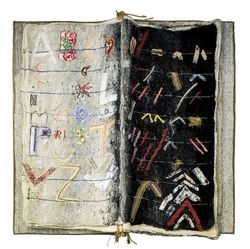Ľuba Belohradská
Bearing in mind visual art history and criticism, Eva Cisárová-Mináriková (born on 1945, Cífer) is a multitalented representative of the Slovak textile art of the late 20th century and the early 21st century. Eva Cisárová-Mináriková is not only an artist producing textile artefacts for domestic and international public spaces, galleries and exhibitions. She was one of the founders of the studio of free textile art at the AFAD in Bratislava (1990 – 2008). In addition to modern life and art, she encouraged students at the studio to discover European historical textile. She came with a new concept of historic textile restoration to the studio. Eva Cisárová-Mináriková was proactive in the introduction of textile traditions of Slovakia at the cultural map of the European historical textile. She promoted revival of the work of renowned Hungarian textile artist of the turn of the 19th and 20th century – designer and embroidery maker Mária Hollósy (who was, by coincidence, closely connected with the same village of Cífer). Visual art theorist Eugénia Sikorová has lately prepared a monograph summarising the contribution of E. C.-M.
E. C.-M. studied textile design headed by prof. Bohdan Mrázek (an innovator of Czechoslovak tapestry in the 1960s) at the Secondary textile school in Brno (1961 – 1965). Then, she graduated from the AFAD in Bratislava (1966 – 1972). She attended a two-year course headed by prof. Ladislav Čemický and studied free-style painting and tapestry course headed by prof. Peter Matejka. And, she did free-style painting and tapestry at the AFAD.
Between 1973 and 1985, Eva Cisárová-Mináriková had a creative period closely connected with historical tapestry. She made four large tapestries in which she incorporated technical copies and artistic interpretations of historical originals. Historical tapestries have become a lifelong inspiration for Eva Cisárová-Mináriková.
Paint´d´weaving – a term invented by the artist herself – reflects the change in her creative inspiration: E. C.-M. goes for colour materials on the expense of opportunities weaving has. E. C.-M. uses net bags for potatoes as a perfect colour fibre. She uses the same material for weaving landscapes. Over the Považie region (1987 – 1988) is the most monumental of all tapestries that have been made from the above material. She also uses recycled industrial textile waste for her creative work.
Typical textile objects she has started to make in the early 1990s are specific for they have multiple interpretations and solutions. The artist presents her work in cycles and series: Calligraphy (1990), Knotgraphy (1993), Calligraphy notes I. – IX. (1994 – 1997). Then, she makes collage textiles from non-woven textile and comes with „textile books“. E. C.-M. works with gender, family, professional, regional and local identities. Textile objects such as A.B.C. Book (1998) and Sample books from the late 1990s represent a unique archive of fragmented textile artefacts.
E. C.-M. also works with textile miniatures and has made decorative or „philosophic“ mini-object Inadequate equipment (2007).
